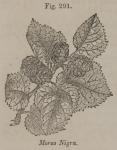117. Morus nigra, Linn.—The Common Mulberry.
 Sex. Syst. Monoecia, Tetrandria.
Sex. Syst. Monoecia, Tetrandria.
(Fructus Succus, L.)
History.—The mulberry (μορέα) is mentioned by Hippocrates [De victus ratione, lib. ii. p. 360, ed. Foes.]—"Mora calefaciunt et humectant ac alvo secedunt," says the Father of Physic. Dioscorides [Lib. i. cap. 180.] also speaks of the mulberry.
Botany.—Gen. Char.—Monoecious. Catkins unisexual. Calyx 4-lobed; the lobes concave. Stamens 4, alternate with the segments of the calyx. Ovary free. Stigmas 2. Seeds 1-2, covered by the pulpy calyx (Bot. Gall.).
Sp. Char.—Leaves cordate, ovate, lobed, or unequally dentate; rough and thickish. Fruit dark purple (Bot. Gall.).
A small tree, with rugged bark. Flowers greenish. "Fruit, consisting of the female flowers, become fleshy and grown together, inclosing a dry membranous pericarp." (Lindley.)
Hab.—Native of Persia and China. Cultivated for its fruit. Flowers in May.
Description.—The fruit is usually called a berry (bacca mori nigrae), but is, in fact, that kind called by botanists a sorosis. Its odour is peculiar and agreeable; its taste is peculiar, pleasant, acidulous, and sweet. The juice is dark violet red.
Composition.—The fruit has not been analyzed. Its principal constituents are—violet-red colouring matter, tartaric acid, sugar, and woody fibre. The root has been analyzed by Wackenroder. [Gmelin's Handb. d. Chem. ii. 1324.]
Physiological Effects.—Mulberries are alimentary in a slight degree; they allay thirst, diminish febrile heat, and, in large quantities, prove laxative.
Use.—They are employed as an agreeable aliment, and are well adapted to check preternatural heat and relieve thirst in fevers, but are objectionable when a tendency to diarrhoea exists. They owe their retention in the Pharmacopoeia to their colour and flavour.
SYRUPUS MORI, L.; Syrup of Mulberry.—(Juice of Mulberries, strained, Oj; Sugar lb ijss; Rectified Spirit f℥ijss. Dissolve the sugar in the mulberry juice with a gentle heat, and set aside for twenty-four hours; then remove the scum, and pour off the clear liquor from the dregs if there are any. Lastly, add the spirit.)—Used as a colouring and flavouring substance. Its acidity prevents its being used with alkalies, earths, or their carbonates.

